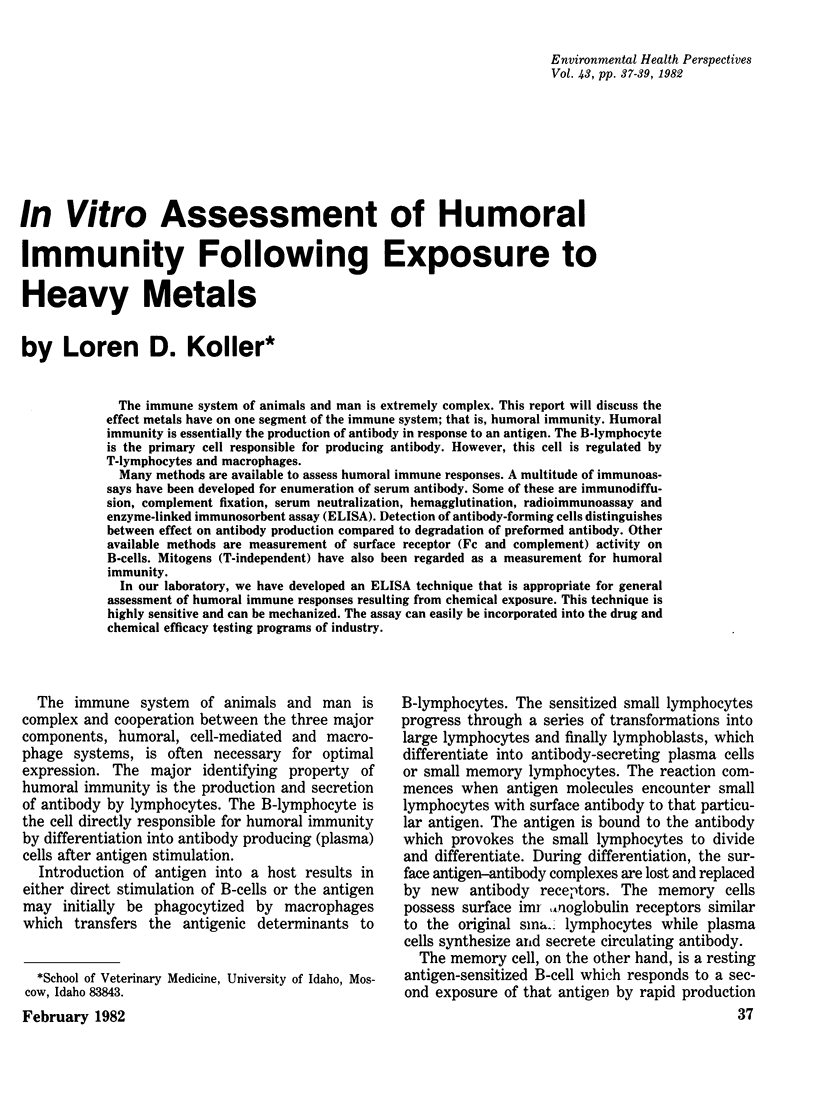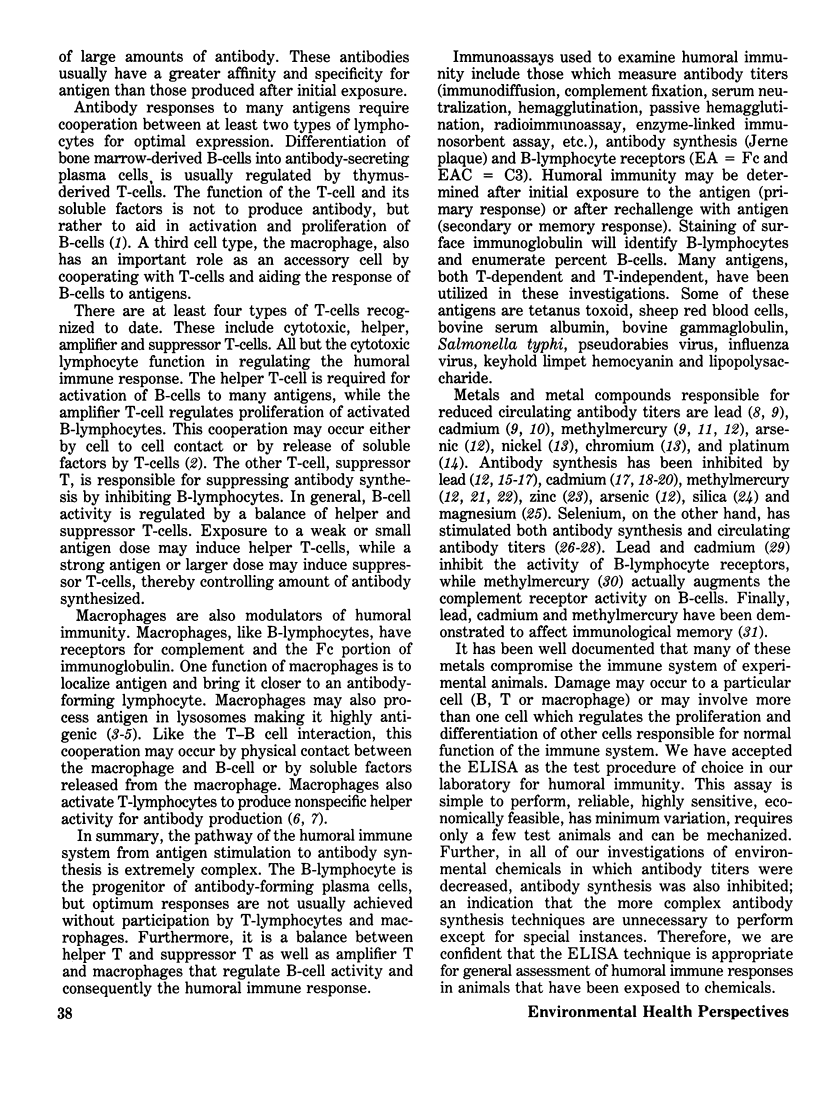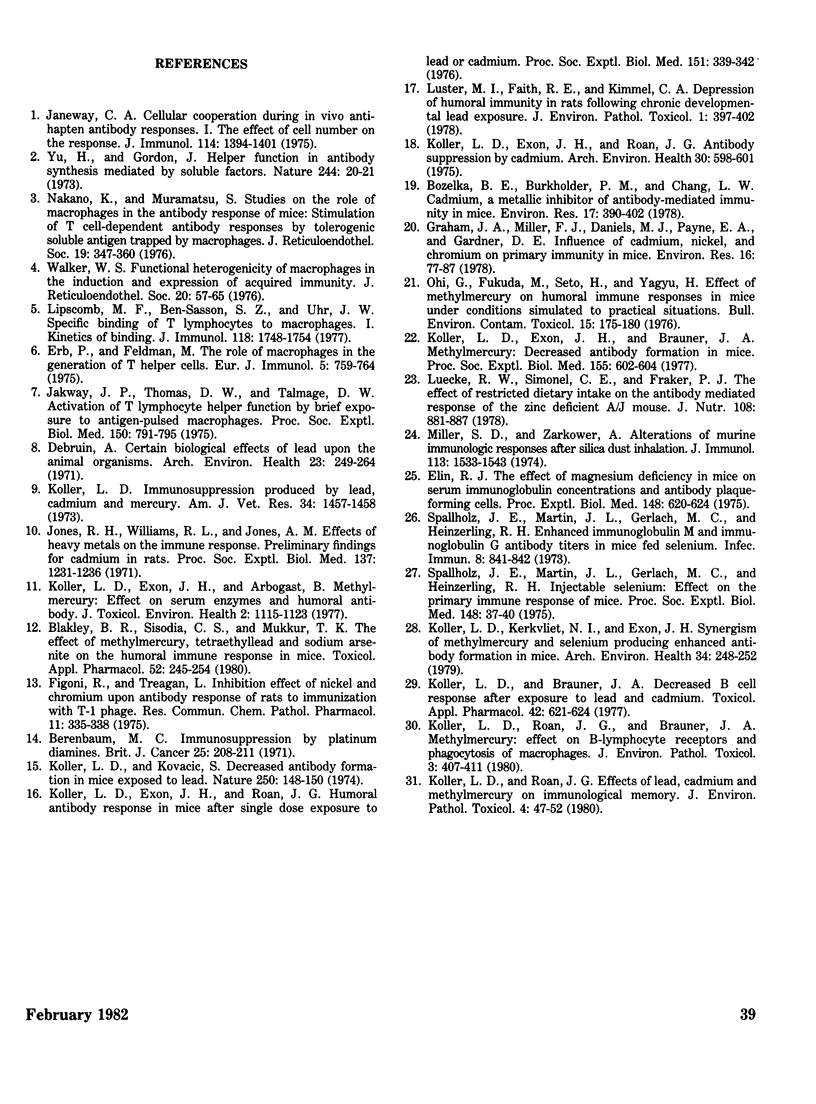Abstract
The immune system of animals and man is extremely complex. This report will discuss the effect metals has on one segment of the immune system; that is, humoral immunity. Humoral immunity is essentially the production of antibody in response to an antigen. The B-lymphocyte is the primary cell responsible for producing antibody. However, this cell is regulated by T-lymphocytes and macrophages. Many methods are available to assess humoral immune responses. A multitude of immunoassays have been developed for enumeration of serum antibody. Some of these are immunodiffusion, complement fixation, serum neutralization, hemagglutination, radioimmunoassay and enzyme-linked immunosorbent assay (ELISA). Detection of antibody-forming cells distinguishes between effect on antibody production compared to degradation of preformed antibody. Other available methods are measurement of surface receptor (Fc and complement) activity on B-cells. Mitogens (T-independent) have also been regarded as a measurement for humoral immunity. In our laboratory, we have developed an ELISA technique that is appropriate for general assessment of humoral immune responses resulting from chemical exposure. This technique is highly sensitive and can be mechanized. The assay can easily be incorporated into the drug and chemical efficacy testing programs of industry.
Full text
PDF


Selected References
These references are in PubMed. This may not be the complete list of references from this article.
- Berenbaum M. C. Immunosuppression by platinum diamines. Br J Cancer. 1971 Mar;25(1):208–211. doi: 10.1038/bjc.1971.27. [DOI] [PMC free article] [PubMed] [Google Scholar]
- Blakley B. R., Sisodia C. S., Mukkur T. K. The effect of methylmercury, tetraethyl lead, and sodium arsenite on the humoral immune response in mice. Toxicol Appl Pharmacol. 1980 Feb;52(2):245–254. doi: 10.1016/0041-008x(80)90111-8. [DOI] [PubMed] [Google Scholar]
- Bozelka B. E., Burkholder P. M., Chang L. W. Cadmium, a metallic inhibitor of antibody-mediated immunity in mice. Environ Res. 1978 Dec;17(3):390–402. doi: 10.1016/0013-9351(78)90042-7. [DOI] [PubMed] [Google Scholar]
- Elin R. J. The effect of magnesium deficiency in mice on serum immunoglobulin concentrations and antibody plaque-forming cells. Proc Soc Exp Biol Med. 1975 Mar;148(3):620–624. doi: 10.3181/00379727-148-38596. [DOI] [PubMed] [Google Scholar]
- Erb P., Feldmann M. The role of macrophages in the generation of T helper cells. III. Influence of macrophage-derived factors in helper cell induction. Eur J Immunol. 1975 Nov;5(11):759–766. doi: 10.1002/eji.1830051106. [DOI] [PubMed] [Google Scholar]
- Figoni R. A., Treagan L. Inhibitory effect of nickel and chromium upon antibody response of rats to immunization with T-1 phage. Res Commun Chem Pathol Pharmacol. 1975 Jun;11(2):335–338. [PubMed] [Google Scholar]
- Graham J. A., Miller F. J., Daniels M. J., Payne E. A., Gardner D. E. Influence of cadmium, nickel, and chromium on primary immunity in mice. Environ Res. 1978 Jul;16(1-3):77–87. doi: 10.1016/0013-9351(78)90144-5. [DOI] [PubMed] [Google Scholar]
- Jakway J. P., Thomas D. W., Talmage D. W. Activation of T-lymphocyte helper function by brief exposure to antigen-pulsed macrophages. Proc Soc Exp Biol Med. 1975 Dec;150(3):791–795. doi: 10.3181/00379727-150-39126. [DOI] [PubMed] [Google Scholar]
- Janeway C. A., Jr Cellular cooperation during in vivo anti-hapten antibody responses. I. The effect of cell number on the response. J Immunol. 1975 Apr;114(4):1394–1401. [PubMed] [Google Scholar]
- Jones R. H., Williams R. L., Jones A. M., Eveland W. C. Effects of heavy metal on the immune response. Preliminary findings for cadmium in rats. Proc Soc Exp Biol Med. 1971 Sep;137(4):1231–1236. doi: 10.3181/00379727-137-35762. [DOI] [PubMed] [Google Scholar]
- Koller L. D., Brauner J. A. Decreased b-lymphocyte response after exposure to lead and cadmium. Toxicol Appl Pharmacol. 1977 Dec;42(3):621–624. doi: 10.1016/s0041-008x(77)80050-1. [DOI] [PubMed] [Google Scholar]
- Koller L. D., Exon J. H., Arbogast B. Methylmercury: effect on serum enzymes and humoral antibody. J Toxicol Environ Health. 1977 May;2(5):1115–1123. doi: 10.1080/15287397709529509. [DOI] [PubMed] [Google Scholar]
- Koller L. D., Exon J. H., Brauner J. A. Methylmercury: decreased antibody formation in mice. Proc Soc Exp Biol Med. 1977 Sep;155(4):602–604. doi: 10.3181/00379727-155-39859. [DOI] [PubMed] [Google Scholar]
- Koller L. D., Exon J. H., Roan J. G. Antibody suppression by cadmium. Arch Environ Health. 1975 Dec;30(12):598–601. doi: 10.1080/00039896.1975.10666787. [DOI] [PubMed] [Google Scholar]
- Koller L. D., Exon J. H., Roan J. G. Humoral antibody response in mice after single dose exposure to lead or cadmium. Proc Soc Exp Biol Med. 1976 Feb;151(2):339–342. doi: 10.3181/00379727-151-39205. [DOI] [PubMed] [Google Scholar]
- Koller L. D. Immunosuppression produced by lead, cadmium, and mercury. Am J Vet Res. 1973 Nov;34(11):1457–1458. [PubMed] [Google Scholar]
- Koller L. D., Isaacson-Kerkvliet N., Exon J. H., Brauner J. A., Patton N. M. Synergism of methylmercury and selenium producing enhanced antibody formation in mice. Arch Environ Health. 1979 Jul-Aug;34(4):248–252. doi: 10.1080/00039896.1979.10667408. [DOI] [PubMed] [Google Scholar]
- Koller L. D., Kovacic S. Decreased antibody formation in mice exposed to lead. Nature. 1974 Jul 12;250(462):148–150. doi: 10.1038/250148a0. [DOI] [PubMed] [Google Scholar]
- Koller L. D., Roan J. G., Brauner J. A. Methylmercury: effects on B-lymphocyte receptors and phagocytosis of macrophages. J Environ Pathol Toxicol. 1980 Jun-Jul;3(5-6):407–411. [PubMed] [Google Scholar]
- Koller L. D., Roan J. G. Effects of lead, cadmium and methylmercury on immunological memory. J Environ Pathol Toxicol. 1980 Nov;4(5-6):47–52. [PubMed] [Google Scholar]
- Lipscomb M. F., Ben-Sasson S. Z., Uhr J. W. Specific binding of T lymphocytes to macrophages. I. Kinetics of binding. J Immunol. 1977 May;118(5):1748–1754. [PubMed] [Google Scholar]
- Luecke R. W., Simonel C. E., Fraker P. J. The effect of restricted dietary intake on the antibody mediated response of the zinc deficient A/J mouse. J Nutr. 1978 May;108(5):881–887. doi: 10.1093/jn/108.5.881. [DOI] [PubMed] [Google Scholar]
- Luster M. I., Faith R. E., Kimmel C. A. Depression of humoral immunity in rats following chronic developmental lead exposure. J Environ Pathol Toxicol. 1978 Mar-Apr;1(4):397–402. [PubMed] [Google Scholar]
- Miller S. D., Zarkower A. Alterations of murine immunologic responses after silica dust inhalation. J Immunol. 1974 Nov;113(5):1533–1543. [PubMed] [Google Scholar]
- Nakano K., Muramatsu S. Studies on the role of macrophages in the antibody response of mice: stimulation of T cell-dependent antibody responses by tolerogenic soluble antigen trapped by macrophages. J Reticuloendothel Soc. 1976 Jun;19(6):347–360. [PubMed] [Google Scholar]
- Ohi G., Fukuda M., Seto H., Yagyu H. Effect of methylmercury on humoral immune responses in mice under conditions simulated to practical situations. Bull Environ Contam Toxicol. 1976 Feb;15(2):175–180. doi: 10.1007/BF01685157. [DOI] [PubMed] [Google Scholar]
- Spallholz J. E., Martin J. L., Gerlach M. L., Heinzerling R. H. Enhanced immunoglobulin M and immunoglobulin G antibody titers in mice fed selenium. Infect Immun. 1973 Nov;8(5):841–842. doi: 10.1128/iai.8.5.841-842.1973. [DOI] [PMC free article] [PubMed] [Google Scholar]
- Spallholz J. E., Martin J. L., Gerlach M. L., Heinzerling R. H. Injectable selenium: effect on the primary response of mice (38472). Proc Soc Exp Biol Med. 1975 Jan;148(1):37–40. doi: 10.3181/00379727-148-38472. [DOI] [PubMed] [Google Scholar]
- Walker W. S. Functional heterogeneity of macrophages in the induction and expression of acquired immunity. J Reticuloendothel Soc. 1976 Jul;20(1):57–65. [PubMed] [Google Scholar]
- Yu H., Gordon J. Helper function in antibody synthesis medicated by soluble factor(s). Nat New Biol. 1973 Jul 4;244(131):20–21. doi: 10.1038/newbio244020a0. [DOI] [PubMed] [Google Scholar]
- de Bruin A. Certain biological effects of lead upon the animal organism. Arch Environ Health. 1971 Oct;23(4):249–264. doi: 10.1080/00039896.1971.10665996. [DOI] [PubMed] [Google Scholar]


